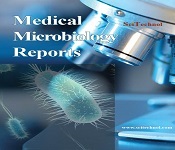Conference Series LLC Ltd and its subsidiaries including I Med Pub and Conference Series Organise 3000+ Conferences across USA, Europe & Asia with support from 1000 more scientific societies and Publishes 700+ Open Access Journals which contains over 50000 eminent personalities, reputed scientists as editorial board members. Conference Series LLC Ltd is an amalgamation of Open Access Publications and worldwide international science conferences and events. Established in the year 2007 with the sole aim of making the information on Sciences and technology "Open Access", Conference Series LLC Ltd publishes scholarly journals in all aspects of Science, Engineering, Management and Technology journals. Conference Series LLC Ltd has been instrumental in taking the knowledge on Science & technology to the doorsteps of ordinary men and women. Research Scholars, Students, Libraries, Educational Institutions, Research centers and the industry are main stakeholders that benefitted greatly from this knowledge dissemination. Conference Series LLC Ltd also organizes 3000+ International conferences across the globe, where knowledge transfer takes place through debates, round table discussions, poster presentations, workshops, symposia and exhibitions.
Applied Microbiology 2018 conference which will be hosted at Ottawa, Canada during October 15-16, 2018; deals with basics of current technology and how microbes can be exploited for human benefit. It has impact of modern molecular biology techniques on Microbial Biotechnology and how this can be employed in an industrial setting, As well as importance of bioprocess monitoring and downstream processing which provides an understanding of how microbial processes affect our environment in beneficial and deleterious ways.
1) Applied Microbiology in Pharmaceutical Microbiology :
It is one of the many facets of Applied Microbiology. It bears on all aspects of pharmacy, from the manufacture and quality control of pharmaceutical products through to an understanding of the mode of action of antibiotics. Other parts of pharmaceutical microbiology incorporate the innovative work of hostile to infective operators, the utilization of microorganisms to identify mutagenic and cancer-causing movement in forthcoming medications, and the utilization of microorganisms in the fabricate of pharmaceutical items like Stem cell and human development hormone, that is responsible for ensuring medications that do not contain harmful levels of the microbes such as bacteria, viruses, yeast & molds. It mainly focuses the manufacturing techniques, process controls and the finished products it attributes the limit and the harmful effects of microorganisms on the drug product.
2) Microbial Biotechnology:
In this study the micro-organisms used to supply products such as bread, beer and wine. Then in the second phase of traditional microbial biotechnology it resulted in the development of acetone-butanol and glycerol fermentations which follows the processes yielding, for example like citric acid, vitamins and antibiotics. Earlier traditional industrial microbiology was merged with molecular biology to yield more than 40 biopharmaceutical products, such as erythropoietin, human growth hormone and Interferons. So now microbiology is a major part in the global industries.
3) Genetics:
The development of morbid conditions or of disease; more specifically the cellular evenstand reactions and other pathogenic mechanisms occurring in the development of disease is pathogenesis. The genetic material of bacteria and plasmids is DNA. The two essential functions of genetic material are replication and expression. Genetic material must replicate accurately so that progeny inherit all of the specific genetic determinants (the genotype) of the parental organism. Expression of specific genetic material under a particular set of growth conditions determines the observable characteristics (phenotype) of the organism. Bacteria have few structural or developmental features that can be observed easily, but they have a vast array of biochemical capabilities and patterns of susceptibility to antimicrobial agents or bacteriophages. These latter characteristics are often selected as the inherited traits to be analyzed in studies of microbial genetics.
4) Diagnostic and Clinical Microbiology:
Diagnostic Microbiology and Infectious Disease keeps you informed of the latest developments in clinical microbiology and the diagnosis and treatment of infectious diseases. This study is packed with rigorously peer-reviewed articles in Bacteriology, Immunology, Infectious Diseases, Mycology, Parasitology, Applied Microbiology and Virology.
Diagnostic Microbiology and Infectious Disease features:
– Informed commentaries on new antibiotics
– Rapid and cost-effective methods in the laboratory
– Instructive case studies with emphasis on complex circumstances.
Diagnostic Microbiology and Infectious Disease also covers such areas as laboratory and clinical management of microbial diseases, epidemiology and pathogenesis of infections, automation in the diagnostic microbiology laboratory, and antibiotic susceptibility testing.
5) Genomics and DNA Sequencing:
Whole-genome sequencing is the most comprehensive method for analyzing the genome. Genomic information has been instrumental in identifying inherited disorders, characterizing the mutations that drive cancer progression, and tracking disease outbreaks. Rapidly dropping sequencing costs and the ability to produce large volumes of data with today’s sequencers make whole-genome sequencing a powerful tool for genomics research. While whole-genome sequencing is commonly associated with sequencing human genomes, the scalable, flexible nature of next-generation sequencing (NGS) technology makes it equally useful for sequencing any species, such as agriculturally important livestock, plants, or disease-related microbes.
6) Microbiota:
The human body is colonized by a vast number of microbes, collectively referred to as the human microbiota. The link between these microbes and our health is the focus of a growing number of research initiatives, and new insights are emerging rapidly. Humans are colonized by many microorganisms; the traditional estimate is that the average human body is inhabited by ten times as many non-human cells as human cells, but more recent estimates have lowered that ratio to 3:1 or even to approximately the same number. Some microbiota that colonize humans are commensal, meaning they co-exist without harming humans; others have a mutualistic relationship with their human hosts.
7) Environmental Microbiology:
Environmental microbiology it is the study of microorganisms that are living in artificial environments such as bioreactors, it is the composition and physiology of microbial communities in the environment. Microorganisms are present widely in the biosphere, and microorganisms presence it invariably affects the environment where they grow. By the effects of microorganisms in the environment can be beneficial or harmful to human measure. So the Beneficial effects of microbes are derived from metabolic activities from the environment, its associations with plants, animals and from their use in food production and biotechnological processes.
8) Molecular Biorobotics:
It is a term representative of the amalgamation of several sciences. Under this banner, fields of bionics, genetic engineering and cybernetics are all in play. This collective study of different sciences coming together has allowed us to explore how robotics can interact with biology. In its wake, Biorobotics essentially allows robotics to be a substantial substitute for biological organism in a chemical as well as a mechanical capacity. Biorobotics replicates the biological understanding of living organisms and reproduces their characteristics through artificial means. The theoretical discipline of comprehensively engineering genetic information to develop new robotic designs is one aspect of Biorobotics. Another aspect is the use of biological specimens as components of a functioning robot.
9)Vaccines:
It is a biological preparation that improves immunity to a particular disease. A vaccine typically contains an agent that resembles a disease-causing microorganism, and is often made from weakened or killed forms of the microbe, its toxins or one of its surface proteins. The agent stimulates the body's immune system to recognize the agent as foreign, destroy it, and "remember" it, so that the immune system can more easily recognize and destroy any of these microorganisms that it later encounters. Vaccines "teach" your body how to defend itself when germs, such as viruses or bacteria, invade it, they expose you to a very small, very safe amount of viruses or bacteria that have been weakened or killed. Your immune system then learns to recognize and attack the infection if you are exposed to it later in life. This is a natural way to deal with infectious diseases.
10) Applied Microbiology in Food Microbiology:
The study of food microbiology includes understanding not only the factors influencing the growth of microorganisms in food systems but also the means of controlling them. The most commonly used forms of bacteriological analysis in food microbiology are detection and enumeration. The presence of specific bacteria and their concentration must be determined, to assess and control safety hazards, the potential for spoilage or to ensure correct product characteristics. The bacteria of interest to food microbiology can be divided into infectious agents, causes of foodborne intoxication, spoilage, and processing aids. Metabolic activity of a bacterium may be considered as causing spoilage or as a processing aid depending upon the desirability of the changes that result.
11) Industrial & Agricultural Microbiology:
This branch of Biotechnology that applies microbial sciences and industries together. It uses microorganisms to produce a desired product in mass quantities in order to make a profit out of it. There are multiple ways to manipulate a microorganism in order to increase maximum yield of product. Introduction of mutations into an organism many be accomplished by introducing them to mutagens. Another way to increase production is by gene amplification, this is done by the use of plasmids, and vectors. The plasmids and/ or vectors are used to incorporate multiple copies of a specific gene that would allow more enzymes to be produced that eventually cause more product yield. The manipulation of organisms in order to yield a specific product has many applications to the real world like the production of some antibiotics, vitamins, enzymes, amino acids, solvents, alcohol and daily products. They can also be used in an agricultural application and use them as a bio pesticide instead of using dangerous chemicals or as inoculants and help plant proliferation.
12) Applied Microbiology in Animals:
Novel aspects of applied microbiology in relation to animal health, It is intended to describe and enhance understanding of the role of microorganisms in animal health and disease, and provides an excellent grounding in microbiology molecular biology, immunology and epidemiology.
This grounding leads into the study of the complex mechanisms of host/microbe interactions that are involved in the pathogenesis of specific animal diseases, and provides insights into diagnosis and interventions, such as vaccines, essential for disease control.
Is concerned with microbial (bacterial, fungal, viral) diseases of domesticated vertebrate animals (livestock, companion animals, fur-bearing animals, poultry, but excluding fish) that supply food, other useful products or companionship. In addition, Microbial diseases of wild animals living in captivity, or as members of the feral fauna will also be considered if the infections are of interest because of their interrelation with humans and/or domestic animals.
13) Applied Microbiology in Nursing:
The adaptation to certain therapies and medications is what makes the study of microbes so important to the nursing profession.
Nurses must have a deep understanding of microbiology in their daily nursing practice.
Although nurses are responsible for caring for their patient, it is not possible to do so without putting health and safety first. Nurses use concepts of microbiology to maintain environments that are free of contamination and infection .Nurses use microbiology in their profession in many ways. When nurses administer smears for the gram positive and negative testing, they use microbiology to analyze the smears for bacterial contamination. Nurses must also use microbiology when it comes to the disposal of biomedical waste of all types. They must determine the proper procedure to handle the waste so that it does not cause infection. The concepts of microbiology help nurses to see beyond what their eyes are able to see. Microbiology helps nursing students build their foundation in the importance of health and safety in the nursing profession. This prerequisite can help nursing students gain a firm grasp of what their day-to-day lives will consist of once they become nurses. Nurses will never look at organisms the same with the help of their Microbiology.
14) Applied Microbiology in Dentistry :
Dentists are exposed to a wide variety of potentially infectious microorganisms in their clinical environment. Applied Microbiology In Dentistry shares knowledge and understanding about the protocols and procedures necessary for working safely. It renders the dentist with the most common oral micro biota and the most appropriate methods for sterilizing dental clinic equipment. Emphasis is focused on applying the standard guidelines of preventive measures to inhibit cross infection for the best practice in dental clinic. Dentists are subjected to the experience of sample collection by medical lab to emphasize microbial experience. Periodontitis and many other oral diseases affecting million people worldwide that is associated with tooth loss and is increasingly considered as a risk factor for systemic diseases such as atherosclerosis. To enable these we occupy a suite of laboratories equipped with bacterial culture, molecular analysis and microscopy (including fluorescence microscopy and TEM). It is collaborated widely with Molecular Microbiology and Biotechnology on the structural biology of bacterial virulence enzymes.
Market research is vital to the development of the industrial market, and continues to be in demand. In 2018, we anticipate delivery of new editions of our report on Microbiology Testing in the Global spurt.
Global Market Survey:
Applied Microbiology & Microbial Biotechnology size was valued at over USD 24.3 billion in 2017 and will exceed USD 675.2 billion with 7.9% CAGR from 2017 to 2024. At Global Market Insights, It is a unique blend of primary and secondary research, with validation and iterations, in order to minimize deviation and present the most accurate analysis of the industry.
Rising demand of new technologies such as DNA sequencing, recombinant technology, fermentation, will drive the biotechnology industry size. we’ve seen tremendous growth and change in the industrial diagnostics industry, particularly in the food safety sector expertise in all aspects of the market, plus extensive experience in business management, strategy development and international business, microbiology test volumes, market values and methods used by food producers around the world, based on detailed interviews with more than 450 food production facilities in America, Europe and Asia, including japan. Total test volumes have increased 128%, and testing for specific foodborne pathogens like Salmonella and E. coli grew at an even faster rate.The global DNA sequencing market is projected to reach USD 85.5 Million by 2025 from USD 310.1 Million in 2017 growing at a CAGR of 8.5% during the forecast period.
The global market for Food Microbiology reached nearly $7.1 billion in 2017. This market is expected to grow to nearly $9.6 billion in 2017 and $15.7 billion by 2025, with a compound annual growth rate (CAGR) of 8.1% from 2017 to 2025.
Global Nanotechnology Market was valued at $216.2 billion in 2017 and $448.3 billion in 2017. The total market is projected to grow at a compound annual growth rate (CAGR) of 19.3% from 2017 through 2025 and reach $828 billion by 2025.
PRODUCT:
Based on technology, the industry is segmented into tissue engineering and regeneration, fermentation, PCR, nanotechnology, chromatography, DNA sequencing and cell based assay. In 2017, the tissue engineering and regeneration segment accounted for highest revenue and was valued at over USD 11.3 billion. However, the nanotechnology, fermentation and cell based assay segments will experience lucrative growth owing to rising R&D initiatives by various biotechnological and pharmaceutical companies.
REGION:
Canada dominated the revenue share in 2017 with over USD 137.4 billion owing to growing R&D initiatives by key industry players and rising awareness among public and private research institute.
European Applied Microbiology market share, along with APAC will show lucrative growth during the coming years due to growing diagnostics and introduction of healthcare benefits by government agencies. The favorable regulatory scenario should propel industry growth in these regions.
MARKET SHARE:
Major Industry Players are:
Abbott
Amgen
AstraZeneca
Biogen
Celgene
Genzyme
Johnson & Johnson
Pfizer
GlaxoSmithKline
Genentech
F. Hoffman La Roche
Novartis
Lonza
Sanofi
Key strategies adopted by the companies to increase global Applied microbiology market share includes mergers and acquisitions, strategic collaborations, outsourcing R&D, healthcare agencies and life sciences.
The Global Pharmaceutical desiccant market of USA is predicted to rise with a CAGR of 6.40% over the forecast period of 2017- 2025, generating revenue of $180133 thousand by the end of 2025.
END-USERS:
Based on the phenomenal grafting need to understand chronic diseases at molecular level and develop novel therapeutic and diagnostic procedures will also motivate these organizations to fund in microbiology sector.
Food products in countries such as Canada , Europe and Japan is one of the main factors driving industrial growth. Rise in prices related with natural non-renewable resource are encouraging researchers to develop.
Capability expansion in areas of forensic diagnostics and forensic sciences should propel nanotechnology business. Cell based assay will also spur during forecast due to its application in cell testing and emerging micro fluid technologies. Bio services segment will show a substantial growth during the forecast timeframe due to growing clinical research initiatives by various biotechnology and pharmaceutical industries.
Top Universities Worldwide:
Stanford University
Massachusetts Institute of Technology (MIT)
Harvard University
University of Cambridge
California Institute of Technology (Caltech)
University of Oxford
UCL (University College London)
ETH Zurich – Swiss Federal Institute of Technology
Imperial College London
University of Chicago
Princeton University
Yale University
Cornell University
Johns Hopkins University
Top Associations Worldwide:
American Society for Microbiology
International Union of Microbiological Societies
Society for Industrial Microbiology and Biotechnology
Microbiology Society
Swiss Society for Microbiology (SSM)
Federation of European Microbiological Societies (FEMS)
Canadian Association for Clinical Microbiology and Infectious Disease
Federation of Immunological Societies of Asia-Oceania (FIMSA)
European Society of Clinical Microbiology and Infectious Diseases
Society for Applied Microbiology
Target Spectators:
Directors, Board Members, Presidents, Vice Presidents, Deans and Head of the Department
Medical practitioners
Microbiologists
Directors of Associations and Societies
Medical universities and colleges
Scientists, Researchers, Faculties, Students
Pharmaceutical & biopharmaceutical Companies
Medical Devices Manufacturing Companies
Laboratory Technicians and Diagnostic Companies
Business Entrepreneurs and Industrialists























